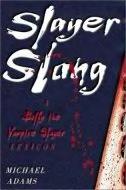From Worldwidewords.org Buffy The Vampire SlayerSlayer Slang ReviewBy Michael Adams Monday 29 September 2003
Buffyology is now definitely on the academic conference circuit : last October the University of East Anglia hosted one entitled Blood, Text and Fears : Reading Around Buffy the Vampire Slayer ; another is to be held in Nashville next May. You can find essays with titles like Sex and the Single Vampire : The Evolution of the Vampire Lothario and Its Representation in Buffy and A Kantian Analysis Of Moral Judgment in Buffy The Vampire Slayer. There are many spin-off books, of which one is "Buffy the Vampire Slayer" and Philosophy : Fear and Trembling in Sunnydale. Many universities now include investigations of the show as part of cultural studies courses. I found comments like this totally over-the-top example, from Professor David Lavery of Middle Tennessee State University : "There is no question that ’Buffy’ is the richest verbal show on television. From the puns to the alliterations to the witticisms, the writing, plain and simple, is fabulous. It is also the funniest show on television." The book falls into two main sections, an introduction that gives the background to Buffy slang, teases out the sources and styles of linguistic invention used by the writers (such as the extensive employment of affixes like -y (twelve-steppy, out-of-the-loopy), -age (slayage, topicage) and über-(überevil, übersuck), and deconstructs the name Buffy in some detail. The rest of the book, the larger part, is a glossary of invented terms used in the Buffyverse. This part of the book will be of interest mainly to slang lexicographers and diehard Buffy fans, since it records the details of who first said a term, in what context, in which episode, plus a note on its etymology. After some study, you will be able to translate sentences like "I’m in a pre-posy with that dollsome Mr ’I Loved The English Patient’ " ("I’m in the early stages of a relationship with that extremely attractive sensitive man"). Is all this effort worthwhile ? If you’re a fan, the answer will no doubt be that it is. Non-watchers like me, even those interested in the evolution of English, may be more equivocal, even though the study of ephemeral English is interesting in itself. Many of us are intrigued by the inventiveness of the writers in creating a self-consistent linguistic universe, but the relevance of the language of the programme to the world outside Sunnydale is less than clear. One verbal trick that has made the transition is the way it turns cultural references into lexical items, often subtly and requiring a sophisticated knowledge of literature and films that you perhaps might not expect a teen audience to possess-as in the reference to the English Patient above, or in phrases like to go Wild Bunch (conduct a Western-style rescue), Did you get anything less heart-of-darknessy ? (that is, depressing), or We must Clark Kent our way through the dating scene (go in disguise). One term for which there’s lots of evidence of imitation is much, which is used as an elliptical comment or question (Egotistic much ?, Off message much ?). Michael Adams has also noticed a small explosion of adding the -y suffix to words. However, a lot of Buffy slang continued and built on earlier trends, such as the Californian high-school, Valley Girl slang lexicon of the eighties, and the teens and twenties crowd may not want to perpetuate that style for much longer. With the first run of the whole series now having finished, the next few years will reveal which terms have moved from sideline to mainstream. The show’s influence is sure to dissipate very quickly, despite all the re-runs that will undoubtedly follow. The book is definitely one for the serious Buffy fan or investigator of pop culture. [Michael Adams, Slayer Slang : A ’Buffy the Vampire Slayer’ Lexicon, published in July 2003 by Oxford University Press ; hardback, pp308 ; ISBN 0-19-516033-9 ; publisher’s price in the US $19.95, in the UK £12.99.] |
 Buffyholic Michael Adams has written in enthusiastic terms about the originality and significance of the language of the cult TV series Buffy the Vampire Slayer. I must confess that I’ve never watched even one episode and was initially more than a little bemused, not only that a professor of English should take the show seriously, but that Oxford University Press should publish the results. But on casting about for enlightenment I found that Buffy has become a fashionable topic among specialists-a lot of academic sweat has gone into analysing Joss Whedon’s story of a blonde teenage girl chosen to combat the forces of darkness.
Buffyholic Michael Adams has written in enthusiastic terms about the originality and significance of the language of the cult TV series Buffy the Vampire Slayer. I must confess that I’ve never watched even one episode and was initially more than a little bemused, not only that a professor of English should take the show seriously, but that Oxford University Press should publish the results. But on casting about for enlightenment I found that Buffy has become a fashionable topic among specialists-a lot of academic sweat has gone into analysing Joss Whedon’s story of a blonde teenage girl chosen to combat the forces of darkness.